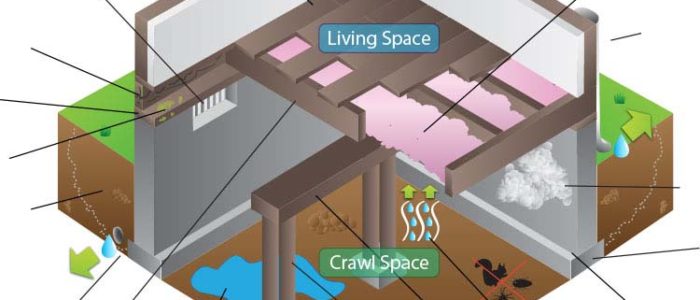8 Common Crawl Space Problems and How to Fix Them
Scientific research and evaluation has demonstrated homes with a properly constructed closed crawl space offer better performance than traditional wall-vented crawl spaces according to Advanced Energy of Raleigh, NC. Advanced Energy has been conducting research on residential crawl spaces in southern climates since 2001 to identify best practice in crawl space design and construction. The Dept. of Energy Building America program has released a guide to retrofitting crawl spaces for Alabama’s mixed-humid climate.
Homes in the southeast US built on vented crawl spaces are more likely to waste energy and suffer moisture damage, mold, insect infestation, and high indoor humidity. While traditional building practices and local codes usually require vented crawl space foundations, the research has demonstrated wall vented crawl-space design contributes to the following home performance problems that often can be solved by enclosing the crawl space according to design guidelines from Advanced Energy and NREL.
Moisture management problems can cause mold and musty smells in the home, buckled hardwood floors, condensation on duct systems, and rot to wood framing because relative humidity in the crawl space can easily exceed 70%.
Crawl space moisture management requires good exterior drainage, air sealing, a ground vapor and gas retarder, an interior drainage mechanism and humidity management system.
Pest control. Reduced crawl space humidity and a vapor retarder may minimize conditions that support insect infestations. The design must provide a termite inspection gap so pest control professionals can inspect and treat the structure.
Carbon Monoxide Safety. To avoid carbon monoxide danger, atmospherically vented combustion appliances must not be installed in a closed crawl space. Any fuel-burning appliance located in a closed crawl space must be a sealed combustion system that draws combustion air from outdoors and returns exhausts gases back outdoors. If there is an existing fuel-fired appliance, it must be replaced with a high efficiency sealed-combustion unit before enclosing the crawl space.
Fire Safety can be improved with fire-rated caulk and sealant at all plumbing, electrical, duct, plenum, and wiring penetrations as part of the work scope.
Insulation. A closed crawl space may be insulated under the floor or at the foundation perimeter, but perimeter insulation is easier to install correctly and reduces energy loss from the duct system. When insulation is aligned with the perimeter wall, it is called crawl space encapsulation and must include a termite inspection gap between the foundation wall and insulation on the band joist.
Radon Control. Radon is a naturally occurring soil gas responsible for over 20,000 lung cancer deaths per year, the second leading cause after smoking. All of north Alabama is classified as high or moderate radon potential. A properly sealed crawl space will prevent radon from entering the living space.
Improved Comfort. A closed crawl space will minimize air infiltration and help keep the home comfortable year-round. Air infiltration allows conditioned air to escape the home and draws outdoor air inside the home. The sealed crawl space blocks water vapor from migrating from the soil to inside the home and will improve indoor humidity levels.
Energy Savings. The Advanced Energy research shows a closed crawl space reduce home energy use by about 15%.
Participating AlabamaWISE home performance contractors specialize in helping homeowners identify home improvements from crawl space to attic to optimize home comfort, energy use and durability. It all starts with a comprehensive home evaluation. AlabamaWISE offers rebates for the assessment when improvements are complete.
You can learn more about the advantages of closed crawl spaces from Advanced Energy at http://www.crawlspaces.org and from Building America http://www.nrel.gov/docs/fy13osti/55624.pdf


Comments are closed.